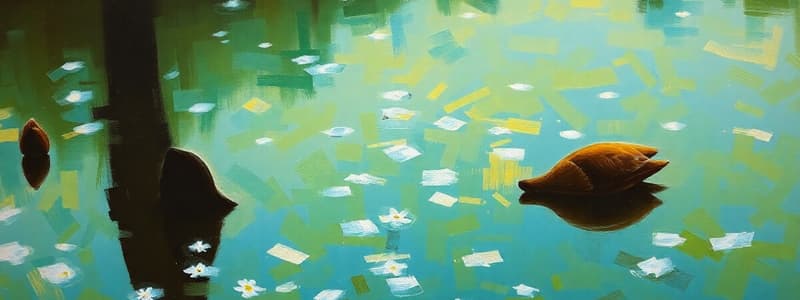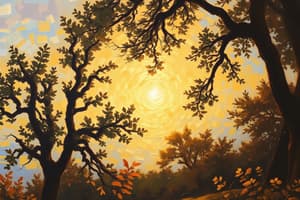Podcast
Questions and Answers
Which statement best reflects Leo Tolstoy's view on the role of art?
Which statement best reflects Leo Tolstoy's view on the role of art?
- Art is primarily a reflection of individual skill and creative imagination.
- Art's main purpose is to represent the beautiful and mysterious ideas of a divine power.
- Art is fundamentally a higher form of knowledge, surpassing even experience.
- Art serves to unite people through shared feelings and contributes to the well-being of humanity. (correct)
How does the concept of 'Art as Imitating and Creating' define the artistic process?
How does the concept of 'Art as Imitating and Creating' define the artistic process?
- Art is solely based on creating entirely new objects without reference to existing forms.
- Art is the act of combining, re-ordering, and assimilating existing materials with personal interpretation. (correct)
- Art involves replicating existing materials precisely to mirror reality.
- Art focuses on imitating previous art styles to preserve cultural heritage.
Which of the following best describes the essence of 'Art as Expression and Communication'?
Which of the following best describes the essence of 'Art as Expression and Communication'?
- Art arises from humanity's need to express itself, utilizing symbols to create understandable representations. (correct)
- Art is a process of imitating involving personal assimilation through mind only.
- Art is an imitation of nature, capturing the world in a realistic manner.
- Art is primarily a display of technical skill and aesthetic beauty.
In what way does the definition of art from Webster's New Collegiate Dictionary intersect with the idea of 'Art as Experience'?
In what way does the definition of art from Webster's New Collegiate Dictionary intersect with the idea of 'Art as Experience'?
According to Manaois, how do 'Fine Arts' differ from 'Practical Arts'?
According to Manaois, how do 'Fine Arts' differ from 'Practical Arts'?
How would you classify an operatic performance, which combines elements of music, poetry and drama, according to the art groupings?
How would you classify an operatic performance, which combines elements of music, poetry and drama, according to the art groupings?
How did the purpose of studying ancient Latin writings shift from the Ancient period to the Renaissance?
How did the purpose of studying ancient Latin writings shift from the Ancient period to the Renaissance?
What role did humanities serve during the Renaissance period?
What role did humanities serve during the Renaissance period?
How does the 'Expressive Theory' of art differ from the 'Representation Theory'?
How does the 'Expressive Theory' of art differ from the 'Representation Theory'?
Which of the following is an example of performing art?
Which of the following is an example of performing art?
How are painting and sculpture different from each other?
How are painting and sculpture different from each other?
How do representational arts differ from non-representational arts?
How do representational arts differ from non-representational arts?
Which of the following is an example of representational art?
Which of the following is an example of representational art?
How does 'Realism' as a method of presenting subjects, differ from 'Surrealism'?
How does 'Realism' as a method of presenting subjects, differ from 'Surrealism'?
What is the focus of 'Futurism' as an art movement?
What is the focus of 'Futurism' as an art movement?
How does 'Expressionism' differ from 'Realism' in presenting the subject?
How does 'Expressionism' differ from 'Realism' in presenting the subject?
Which art movement emphasizes simplicity and the use of geometric shapes?
Which art movement emphasizes simplicity and the use of geometric shapes?
Which art movement uses color as the primary means of expression?
Which art movement uses color as the primary means of expression?
Which of the following would be considered a 'non-objective' artwork?
Which of the following would be considered a 'non-objective' artwork?
How does 'pointillism' technique work?
How does 'pointillism' technique work?
Flashcards
What is Art?
What is Art?
Power, creativity, expression, and communication that lifts our spirit and impacts our moods and emotions.
Webster's definition of 'Art'
Webster's definition of 'Art'
The conscious use of skill and creative imagination, especially in the production of aesthetic objects.
Art as Imitation and Creation
Art as Imitation and Creation
Creation involves combining or re-ordering existing materials, resulting in new objects with personal assimilation of mind, feeling and style.
Art is Universal
Art is Universal
Signup and view all the flashcards
Art is Timeless
Art is Timeless
Signup and view all the flashcards
Webster (1987) on Major vs. Minor Arts
Webster (1987) on Major vs. Minor Arts
Signup and view all the flashcards
Fine Arts
Fine Arts
Signup and view all the flashcards
Practical Arts
Practical Arts
Signup and view all the flashcards
Performing Arts
Performing Arts
Signup and view all the flashcards
Literary Arts
Literary Arts
Signup and view all the flashcards
Popular Arts
Popular Arts
Signup and view all the flashcards
Visual Arts
Visual Arts
Signup and view all the flashcards
Drama and Theater
Drama and Theater
Signup and view all the flashcards
Dance
Dance
Signup and view all the flashcards
Visual Arts
Visual Arts
Signup and view all the flashcards
Painting
Painting
Signup and view all the flashcards
Sculpture
Sculpture
Signup and view all the flashcards
Architecture
Architecture
Signup and view all the flashcards
Plastic Arts
Plastic Arts
Signup and view all the flashcards
Dance
Dance
Signup and view all the flashcards
Study Notes
Defining Art
- Art encompasses power, creativity, expression, and communication
- It can elevate the spirit and enrich life
- Art has profound effects on moods and emotions
- Conveying feelings and expressions, art is the lifeblood of humanities
- Art motivates people to create and appreciate beauty
- The term "art" comes from the Latin word "ars," signifying ability or skill
Perspectives on Art
- According to Webster's Dictionary, art involves the conscious application of skill and creative imagination in producing aesthetic objects
- Leo Tolstoy saw art as a means to unite people in feeling, essential for the well-being and advancement of individuals and humanity
- Aristotle considered art a higher form of knowledge than experience
- Jean Anouih believed art's purpose is to give shape to life
- Oscar Wilde defined art as the most intense mode of individualism
- Frank Lloyd Wright viewed art as discovering and developing nature's principles into forms suitable for human use
- Jean Couteau described art as science in the flesh
- James Adam asserted that all art is social
Core Aspects of Art
- Art is a ubiquitous phenomenon
- Creation in art is combining or reorganizing existing materials to form new objects
- Art is a process of imitation that involves personal assimilation through mind, feeling, and style
- Art is universal because it transcends cultures, races, and civilizations
- Art is timeless because it goes beyond the constraints of time
- Art is a form of expression and communication arising from the human need to express oneself using symbols
- Art enables the artist to convey experiences
Art and Experience
- Art and experience encompass the artist's expression and the onlooker's interpretation
- Major arts involve skill to create aesthetic works, while minor arts focus on styling, according to Webster
Dimensions of Art
- According to Manaois, art has 3 dimensions
- Fine or Independent arts are for aesthetic enjoyment
- Practical or Utilitarian Arts focus on developing raw materials
Categories of Art
- Performing arts include theater, play, dance and music, involving movement, speaking, and gestures
- Literary arts include short stories, novels, poetry, and dramas
- Popular arts include film, newspapers, magazines, radio, and television; characterized as gay and lively
- Abad, and Jao grouped art into Visual, Drama and theater and Dance
- Visual arts include graphic arts like drawing, painting, and photography
- Drama includes tragedy, melodrama, and comedy
- Dance encompasses ethnologic, social, ballroom, ballet, modern, and musical comedy
- Kinetic arts involve rhythmic movement
- Pure arts use one medium of expression like sound or color
- Mixed arts use two or more media, like opera
Main Categories
- Visual Arts
- Literary Arts
- Performing Arts
Historical Views of Art
- Ancient art was applied to Latin authors' writings for clarity, literary style, and moral teaching
- Medieval art focused on metaphysics, religion, spiritual cultivation, and preparation for the afterlife
- Renaissance art referred to disciplines taught in universities, providing skills and values through humanities
Expressive vs. Representational Art
- Expressive theory views art as representing the artist's inner state
- Music is viewed as expressing feelings, emotions, moods, and conflicts
- Internal art focuses on humanities, whereas external art focuses on science
- Representational theory views art as portraying visible forms of nature
- A representational artist seeks faithfulness in portraying things
Classifications of Art
- Visual arts involve primarily visual creations
- Painting involves applying paint, pigment, and color, derived from LW(pingere) meaning to paint
- Sculpture involves carving, modeling, casting, assembling, and constructing, derived from LW(sculpere) meaning to cut
- Architecture is the art of designing and constructing buildings
- Plastic arts have three-dimensional forms
- Dance involves rhythmic body movement dependent on music and non-verbal communication
- Music combines sounds of varying pitches like vocal, instrumental, opera, and musical comedy
- Theater is a play or drama recreated by actors in a dramatic form
- Film is the art of moving images, manipulating reality through image and sound
- Literary arts consist of written material like poetry, novels, poems, and drama
- Digital arts, like graphic arts, have a two-dimensional surface like painting, drawing, and photography
More Categories of Art
- Pop art is lively and includes film, newspaper, magazines, radio, and TV
- Gustatory art involves skill in food preparation
- Decorative arts are visual objects produced for aesthetic functions in houses, interior designs, offices, and cars
Subject in Art
- The subject is what is represented in the artwork, whether it's a person, object, scene, or event
- Non-objective art does not have a subject
Types of Subject
- Representational or Objective Arts portray recognizable subjects or objects that are real
- Portraiture depicts men and women and was popular before cameras
- Animals and Plants or Flora and Fauna represent animals and plants, from man's early encounters
- Still Life depicts inanimate objects
- Country Life depicts community scenes
- Landscape depicts land forms
- Seascape depicts water forms
- Cityscape depicts aerial views of cities
- Events depict occurrences like Spolarium and Blood Compact
- Religious Items depict holy figures
- Mythological, fictional, and cartoon characters represent mythological or fictional characters
- Non-Representational or Non-Objective Arts do not resemble anything real
- Abstract art departs from reality, with degrees of abstractness varying based on similarity to the real world
Methods or Presenting the Subjects
- Realism/naturalism represents things accurately
- Surrealism means super naturalism or beyond realism
- Cubism, popularized by George Brague and Pablo Picasso, emphasizes geometry
- Expressionism, introduced in Germany, emotionally expresses the real-life subject by focusing on feelings
- Impressionism was introduced through studio painting
- Symbolism uses visible signs or objects to represent absolute reality
- Pointillism is the result of science, colors, and optics from George Seurat and Paul Signac
- Futurism originated in Italy in the early 20th century, focusing on machines and motion
- Minimalism emphasizes shapes and space, focusing on decorative displays
- Fauvism flourished with Henri Matisse and Andre Derain, focusing on color
- Dadaism is considered shocking realism
- Pure Abstractionism means "drawing away from reality"
Studying That Suits You
Use AI to generate personalized quizzes and flashcards to suit your learning preferences.




